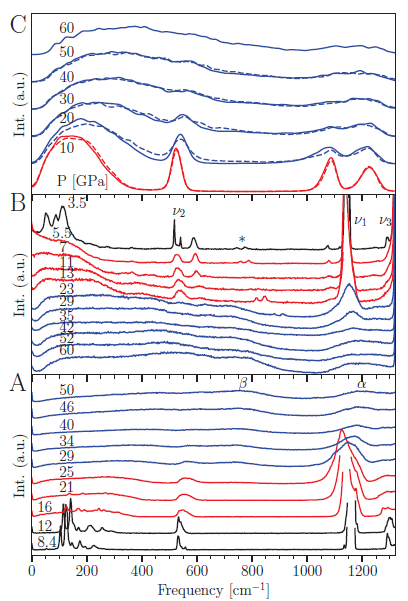
Some substances are known to exist in several different structurally disordered solid states, a phenomenon known as polyamorphism.
The first and perhaps most celebrated example of polyamorphic behavior was discovered in water ice in 1984 by Mishima et al. Two different forms of amorphous water ice were identified, known as low-density amorphous and high-density amorphous ices. Later on, similar phenomena were also observed in other important systems such as Si, SO2, and GeO2.
In condensed matter physics, polyamorphism is a very interesting but poorly understood phenomenon.
Recently, a team of Chinese scientists and their collaborators at the Institute of Solid State Physics of the Hefei Institutes of Physical Science examined polyamorphism in the molecular substance SO2.
While exploring phase transition in dense SO2, they found pressure-induced amorphization in dense sulfur SO2 and a reversible pressure-induced structural transformation between the molecular amorphous and polymeric amorphous forms of SO2. This work was published in PNAS on April 3.
SO2 plays a significant part in chemistry research and in the physics of the Earth and atmosphere. While properties of similar solid molecular systems such as CO2 or N2 at high pressures have been extensively studied, more research on dense SO2, especially its behavior and properties, still needs to be done.
In this study, scientists took a closer look at this simple molecule through a combined experimental and computational effort that tried to describe some new and unexpected phenomena.
By using experimental techniques of Raman spectroscopy and X-ray diffraction at high pressures, they compressed SO2 up to 60 GPa with a diamond anvil cell and explored the phase transitions and structures of SO2 up to 60 GPa and at temperatures ranging from 77-300 K.
At 77 K and below 16 GPa, sulfur dioxide was crystalline. When compressed to 16 GPa, the sulfur dioxide in the crystalline phase went through pressure-induced amorphization and entered the amorphous phase of the molecular state. When further compressed to above 26 GPa, a phase transition occurred from the molecular amorphous phase (two-coordinated sulfur) to the chain polymeric amorphous phase (three-coordinated sulfur).
The researchers studied several different temperature paths and found that the phase transition path in dense SO2 proceeded from the crystalline to the molecular amorphous phase and then to the polymeric amorphous phase over the entire temperature range of 77-300 K. They also discovered that the phase transition path was reversible.
Furthermore, the amorphization pressure changed with temperature, ranging from 10-16 GPa across the 77-300 K temperature range.
To test their observations, the team used molecular dynamics simulations and the same phenomenon was also observed. In particular, the high-pressure polymeric amorphous form was found to consist mainly of disordered polymeric chains made of three-coordinated sulfur atoms connected via oxygen atoms, and few residual intact molecules.
he amorphous molecular to amorphous polymeric transition identified in this research may also suggest the possible existence of a similar transition in the liquid state.
This work was supported by the National Nature Science Foundation of China, the Chinese Academy of Sciences (CAS) President’s International Fellowship Initiative, the Science Challenge Project, the CAS Innovation Fund and the Director’s Fund of Science Island.

Vibrational spectra of solid SO2. (A and B) Selected Raman spectra of an SO2 sample measured upon (A) increasing pressure at 77 K and (B) decreasing pressure at room temperature. (C) Evolution of VDOS from ab initio MD simulations along compression (solid lines) and decompression (dashed lines) at T =300 K. Color represents structural state of the system: black, molecular crystal; red, molecular amorphous; blue, polymeric amorphous. (Image by LIU Xiaodi)

(A–C) Snapshots of the amorphous sample from MD simulations at different pressures. (A) The beginning of compression at 10 GPa where the sample consists only of SO2 molecules. (B) Structure during compression at 40 GPa where the sample contains both molecules and polymeric chains. (C) Structure after decompression to 10 GPa where the sample reverted from polymeric back to molecular. Simulation supercells are not to scale. (D and E) Comparison of polymeric chains in crystalline and amorphous forms of SO2 . (D) Chains in crystalline Ama2 and Pmc21 phases. (E) Selected disordered chain in a configuration of a-SO2 from MD simulation at 30 GPa. The color of S atoms represents coordination: two-coordinated atoms (molecule) are yellow, and three-coordinated ones (polymeric chains) are blue-gray. (Image by LIU Xiaodi)

86-10-68597521 (day)
86-10-68597289 (night)

52 Sanlihe Rd., Xicheng District,
Beijing, China (100864)

